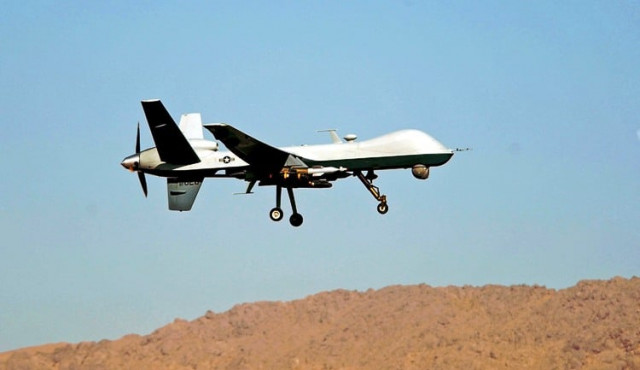
“Some CIA operators are concerned that, because of its blowback effect, it is doing more harm than good,” said Jeffrey Addicott, former legal adviser to US Special Forces & director Center for Terrorism Law at St Mary's University in San Antonio, Texas, in an interview with Inter-Press Service (IPS).
Addicott said the CIA operatives he knows told him that drone strikes are being used effectively by Al Qaeda and Taliban leaders to recruit more militants. CIA officers “are very upset with the drone strike policy. They'll do what the boss says, but they view it as a harmful exercise. They say we're largely killing rank and file Pakistani Taliban, and they are the ones who are agitated by the campaign.''
Because drone strikes kill innocent civilians and bystanders along with leaders from far away, they “infuriate Muslim males,” said Addicott thus making them more willing to join the movement. The men in Pakistan's tribal region “view Americans as cowards and weasels.”
Addicott retired from the US Army as lieutenant colonel in 2000 after serving for six years as senior legal adviser to Special Operations Forces but is still a consultant for the US military on issues of terrorism and law. He said CIA officers expressing concern about blowback effects of drone policy are “mid-grade and below.” They learned about the impact of drone strikes on recruiting by extremist leaders in Pakistan from intelligence gathered by CIA & National Security Agency, which intercepts electronic communications.
They informed high-level CIA officials about their concerns that the program is backfiring. “People at the top are not believers,” said Addicott, referring to the CIA. “They know that the objective is not going to be achieved.”
Drone strikes helping Al Qaeda
The complaints by CIA operatives about drone strikes' blowback effect reported by Addicott are identical to warnings by the military and intelligence officials reported in April 2009 by McClatchy News Service.
McClatchy quoted an intelligence official with deep involvement in Afghanistan and Pakistan as saying Al Qaeda and Taliban had used the strikes in generating propaganda to “portray Americans as cowards who are afraid to face their enemies and risk death.” Official called the operations “a major catalyst” for jihadi movements in Pakistan.
A military official involved in counterterrorism operations told McClatchy that the drone strikes were a “recruiting windfall for Pakistani Taliban.” CIA operatives' opposition to the drone strikes program extends to Afghanistan, Yemen, Somalia, Sudan, all of which now have confirmed deaths from drone strikes, according to Addicott.
Official goal of the geographical expansion of drone strikes is to destroy or disrupt Al Qaeda. But Al Qaeda today is less of a major organization than “a mentality” in most Middle Eastern states, Addicott said, and CIA officers fear strikes will only reinforce that way of thinking.
Drone strikes against a short list of high-level Al Qaeda officials
He said the drone program has been driven by President Obama, rather than CIA. “Obama's trying to show people that we're winning.” The program was originally authorized by President George W Bush against a relatively short list of high-level Al Qaeda officials, and with highly restrictive conditions on approval of each strike. The strike could not be approved unless the target was identified with high confidence, and a complete assessment of “collateral damage” had to ensure against significant civilian casualties.
In early 2008, however, Bush approved removal of the previous restraints. As recounted by David Sanger in his 2009 book, “The Inheritance”, Bush authorized strikes against targets merely based on visual evidence of a “typical” Al Qaeda motorcade or a group entering a house that had been linked to Al Qaeda or its Pakistani Taliban allies.
As a top national security aide to Bush acknowledged to Sanger, shift was “risky because, you can hit the wrong house or mistakenly misidentify a motorcade.” It also meant that anyone who could be linked in some way to Al Qaeda, Taliban or “associated forces” could now be targeted for drone attacks.
The Obama administration continued to justify the program as aimed at high-value targets, suggesting it can degrade Al Qaeda as an organization by a “decapitation” strategy, according to Addicott. Administration officials now privately admit the objective of program is to “demoralize rank and file. That won't work, because, these are tribal people. They don't view life and death the way we expect them to.”
Doing something
Within the Obama administration, it appears the logic behind the program is that it has to be seen to be doing something about Al Qaeda. “Argument I get from people associated with the program,” said Micah Zenko, a fellow in conflict prevention at Council on Foreign Relations, “is the same as the one (CIA Director Leon) Panetta gave last year.”
All other tools that might be used to try to reduce Al Qaeda's influence in Pakistan and elsewhere take a long time, require cooperation among multiple actors and have no powerful political constituency behind them, Zenko observed.


















COMMENTS
Comments are moderated and generally will be posted if they are on-topic and not abusive.
For more information, please see our Comments FAQ